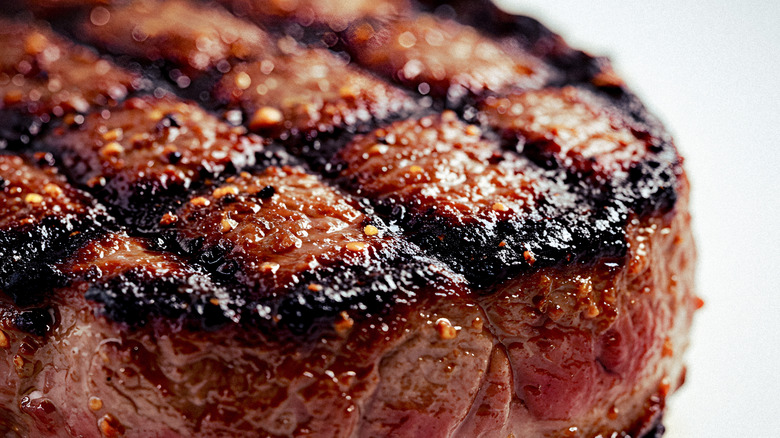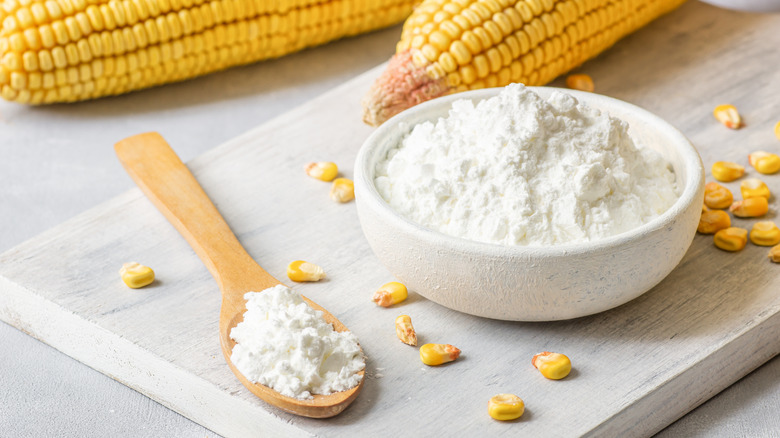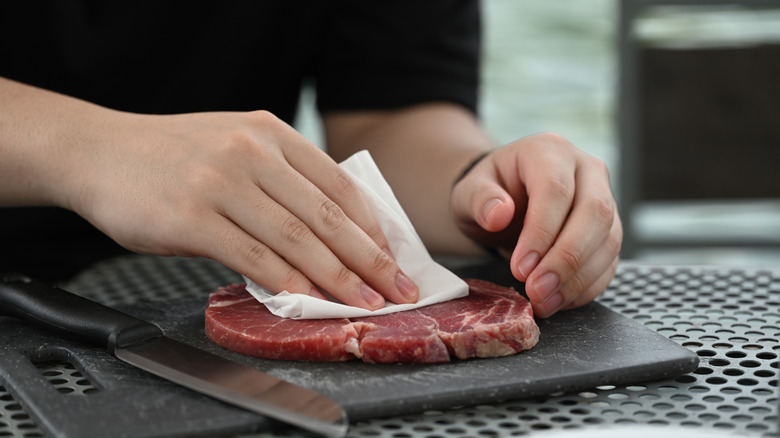Coat Steaks With This Pantry Ingredient For The Perfect Sear
We may receive a commission on purchases made from links.
There's a secret, unconventional method to a perfectly seared steak, and you'll find it in your pantry. A dusting of that kitchen staple, cornstarch, helps dry the surface of the steak. A super-dry surface helps the steak develop that coveted crust, which is why it's so important to always blot your steak with a paper towel. But in this case, a paper towel isn't enough for an extraordinarily crispy crust. To achieve that, you'll need a little extra help from cornstarch and its unique water-absorbing properties.
The technique is based on Argentinian-style steaks, or churrasco. They're cooked low and slow over a wood fire — the complete opposite of the near-instant sear that American chefs strive for. The longer cook time helps the steak develop its iconic crust, which is the key to good churrasco. Traditionally, the crust isn't just crispy, it's crunchy: Fans describe it as a lightly breaded texture. And guess what? Cornstarch helps with that, too.
Why cornstarch works
The crusty surface of a well-seared steak comes from the Maillard reaction. For the uninitiated, the Maillard reaction happens when food is exposed to high heat. The proteins and sugars undergo chemical changes, altering both the color and the flavor compounds. It's what turns bland bread into crisp, delicious toast — and it's what makes crusty steak so irresistible, too.
Typically, the Maillard reaction happens between 280 and 330 degrees Fahrenheit. But before the reaction can occur, any surface moisture first needs to evaporate. Just as sweat cools your body through evaporation, moisture will cool the surface of a steak. But it's important to know that the meat is still cooking while the moisture burns off. If you're not careful, you could cook the steak through before it even starts to brown.
But while evaporation is the enemy of steak, it's also the key to a cornstarch crust. When water evaporates from corn starch, it changes the starch's structure. The starch turns into a clear gel, and once the water in the gel completely evaporates, you're left with a crispy crust.
Steak isn't the only thing that benefits from a cornstarch coating. Cornstarch is also the secret to keeping your fried chicken crispy. And tofu dredged in cornstarch, fried and seasoned with soy sauce, turned me into a tofu fan. Cornstarch can even tenderize meat. Velveting, a Chinese technique that involves marinating meat in cornstarch, uses the starch to break down proteins.
How to give steaks a cornstarch crust
Traditional churrasco steaks — and the cornstarch method — work best with extra-thick cuts of meat. Thick steaks won't overcook during the long grilling process, so the meat has plenty of time to develop a complex smoky taste and that coveted crust. Naturally, steaks made with this method will taste a little different from standard American steakhouse fare, so you may want to try the technique when you're feeling experimental.
Look for 1 ½ to 2-inch-thick strip steaks. Dry them thoroughly before rubbing them down with a mixture of cornstarch and salt. You don't need too much starch: A 2:1 salt to cornstarch ratio is sufficient.
Coat all sides with the cornstarch mixture, then let the steaks rest on a wire rack over a baking sheet. You can also try another unconventional approach: Pop the steak in the freezer after you've given it its cornstarch bath. It's a technique that goes directly against traditional advice. Typically, steak stans will tell you to bring the meat to room temperature before cooking to ensure perfectly-rested steaks every time.
So why the freezer? The cold air helps further dry things out, and the low temperature lets you keep the steak on the grill longer. It doesn't need to rest for too long — 30 minutes will do. Cook the steaks on a hot grill, flipping back and forth until the meat develops a thick char.


